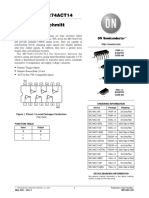0 ratings0% found this document useful (0 votes)
26 viewsBody Safety and Permitted Potential Difference Allowable Body Current Limit
Body Safety and Permitted Potential Difference Allowable Body Current Limit
Uploaded by
balasimThe document discusses allowable electric current and voltage levels for human bodies. It defines sensory, extrication, and fatal current thresholds and provides equations to calculate maximum permitted current and voltage levels based on duration of exposure and body weight. For a 50kg human, the allowable body current is 116mA for 1 second of exposure and the corresponding allowable body voltage is 116V.
Copyright:
© All Rights Reserved
Available Formats
Download as PPTX, PDF, TXT or read online from Scribd
Body Safety and Permitted Potential Difference Allowable Body Current Limit
Body Safety and Permitted Potential Difference Allowable Body Current Limit
Uploaded by
balasim0 ratings0% found this document useful (0 votes)
26 views18 pagesThe document discusses allowable electric current and voltage levels for human bodies. It defines sensory, extrication, and fatal current thresholds and provides equations to calculate maximum permitted current and voltage levels based on duration of exposure and body weight. For a 50kg human, the allowable body current is 116mA for 1 second of exposure and the corresponding allowable body voltage is 116V.
Original Description:
lecture
Original Title
تاريض2
Copyright
© © All Rights Reserved
Available Formats
PPTX, PDF, TXT or read online from Scribd
Share this document
Did you find this document useful?
Is this content inappropriate?
The document discusses allowable electric current and voltage levels for human bodies. It defines sensory, extrication, and fatal current thresholds and provides equations to calculate maximum permitted current and voltage levels based on duration of exposure and body weight. For a 50kg human, the allowable body current is 116mA for 1 second of exposure and the corresponding allowable body voltage is 116V.
Copyright:
© All Rights Reserved
Available Formats
Download as PPTX, PDF, TXT or read online from Scribd
Download as pptx, pdf, or txt
0 ratings0% found this document useful (0 votes)
26 views18 pagesBody Safety and Permitted Potential Difference Allowable Body Current Limit
Body Safety and Permitted Potential Difference Allowable Body Current Limit
Uploaded by
balasimThe document discusses allowable electric current and voltage levels for human bodies. It defines sensory, extrication, and fatal current thresholds and provides equations to calculate maximum permitted current and voltage levels based on duration of exposure and body weight. For a 50kg human, the allowable body current is 116mA for 1 second of exposure and the corresponding allowable body voltage is 116V.
Copyright:
© All Rights Reserved
Available Formats
Download as PPTX, PDF, TXT or read online from Scribd
Download as pptx, pdf, or txt
You are on page 1of 18
Body Safety and Permitted Potential Difference
Allowable Body Current Limit
• An electric shock accident is usually determined by the
frequency, magnitude and duration of the current
passing through the vital part of a human (this generally
refers to the heart). When a current passes through the
heart it causes ventricular fibrillation.
• Generally, the minimum current a human can feel is
about 1 mA, and the stimulation of a human body
caused by a current of 9–25 mA is rather painful. It may
make muscles lose control and it may be difficult or
impossible to unclamp a charged object held in the
hand.
• When the current becomes greater, heart
fibrillation occurs and causes death. Therefore,
the critical value of an electric shock current
causing ventricular fibrillation is the main
issue to be considered in the safety design of a
grounding device. For an AC current with a
frequency of 50 Hz, it can be classified into
three categories according to human responses:
• Sensory current: this is the minimum current
a human can feel. For a male adult it is 1.1
mA, and for a female adult it is 0.7 mA.
• Extrication current: this is the maximum
current that can be extricated by human after
electroshock. It is also related to gender, for a
male adult it is 16 mA and for a female adult it
is 10.5 mA.
• Fatal current: this is the minimum current that
threatens life in the shortest time, by causing
ventricular fibrillation.
• The value of the current plays a vital role in
electroshock on the human body. However, when
current passing through the body, the duration of the
current must also be considered. According to
analysis, if the duration is very short, the current that
a human can tolerate and which does not cause
ventricular fibrillation is:
where the unit of is A; and K is an energy
coefficient related to the weight of the human body.
• The energy coefficients of 50 and 70 kg humans
are K50 = 0.0135 and K70 =0.0247 , respectively.
Therefore, we can get the allowable body current
IK50 for a 50 kg human :
• According to the calculation result from Equation
above, the permitted current corresponding to 1 s
duration is 116 mA, while that corresponding to
0.1 s is 367 mA and that corresponding to 0.05 s
is 519 mA.
• The allowable body current IK70 for a 70 kg
human is
Allowable Body Voltage
• Multiplying the allowable body current IK by
the body resistance RB, we can obtain the
allowable body voltage USV:
• In a solidly grounded system, a single-phase or
two-phase ground fault cannot exist for a long
time, so substituting Equation current into
voltage Equation, the short-time allowable
body voltage for a 50 kg human is:
• Also the allowable body voltage for a 70 kg
human can be obtained:
• If we assume the body resistance RB =1000 V
and t = 1 s, the allowable body voltage in 1 s
for 50 and 70 kg humans are 116 and 157 V,
respectively.
Allowable Potential Difference
• The allowable potential difference of a human
body involves the touch voltage, step voltage .
The step voltage is the difference in surface
potential experienced by a person bridging a
distance of 1 m with his two feet without
contacting any other grounded object, whereas
the touch voltage is the potential difference
between the ground potential rise (GPR) and the
surface potential at the point where a person is
standing, while at the same time his hand is in
contact with a grounded object.
• After obtaining the allowable body current by
Equations above, when the appropriate
parameters of the human body are
determined, we can calculate the allowable
potential difference generated between the
contact points.
• the external current may have two parallel paths:
one is the direct path through the earth, the
other is through the external parallel circuit.
• Because the fault current is as high as several
hundred to several thousand amperes, while the
allowable body current must be limited to a milli
ampere level, the influence of the body on the
applied voltage can be neglected.
• We can assume that all the potential differences
before the electroshock are not changed.
• When one walks on the ground, the touch
resistance RF between the two feet and the
ground surface and the body resistance RB are
connected in series, and the permissible step
voltage US between the two feet is:
• where Vs is the potential difference between
two points where no person stands.
• When a person stands on the ground and
contacts any grounded metal conductor, the
touch resistances between the two feet and
the ground are in parallel, and the actual
voltage (i.e., the permissible touch voltage UT)
between one hand and one foot is:
• where VT is the potential difference between
two points where no person stands.
• When the feet are in contact with the ground, the
touch resistance RF between one foot and the
ground surface has a strong influence on the
body current. Usually, one foot is regarded as a
round plate with radius b (in cm) and then, in
uniform soil, RF can be calculated by:
• If the resistivity of the surface soil is assumed as
200 Ωm, the body resistance as 1000 Ω, Usually,
one foot is regarded as a round plate with radius
b (in cm) , IF b=8
the step voltage US and the touch voltage UT
calculated by Equations above are:
if RF = 3
You might also like
- The Basics of Electric ShockDocument4 pagesThe Basics of Electric ShockAnandababuNo ratings yet
- Shielding Effect Among Grounding ConductorsDocument34 pagesShielding Effect Among Grounding ConductorsbalasimNo ratings yet
- Lec # 04 Substation GroundingDocument19 pagesLec # 04 Substation GroundingMuhammad Ali ImranNo ratings yet
- Voltage: CurrentDocument21 pagesVoltage: CurrentHeidi RiegoNo ratings yet
- Guideline For Earthing of SubstationDocument12 pagesGuideline For Earthing of SubstationSANJAYNo ratings yet
- Electrical SafetyDocument10 pagesElectrical Safetycarlos_eqnNo ratings yet
- Lec Rec 1.1 - Electrosurgery Basic Electrical PrinciplesDocument4 pagesLec Rec 1.1 - Electrosurgery Basic Electrical PrinciplesDaniel FalconNo ratings yet
- Significance of Step and Touch VoltagesDocument5 pagesSignificance of Step and Touch VoltagesQuek Swee XianNo ratings yet
- Electric ScenarioDocument14 pagesElectric ScenarioAbdul RehmanNo ratings yet
- Diapositivas 2Document53 pagesDiapositivas 2Carlos LLivisacaNo ratings yet
- 02 Electric-ShocksDocument43 pages02 Electric-ShocksSubash PandeyNo ratings yet
- ElectrocutionDocument10 pagesElectrocutionDayah MedizineNo ratings yet
- The Practical Benefits in Ohms Law Is Determining The Barriers Can Replacement of Each Circuit, Radios Ad TVDocument2 pagesThe Practical Benefits in Ohms Law Is Determining The Barriers Can Replacement of Each Circuit, Radios Ad TVJuju ManullangNo ratings yet
- EarthingDocument91 pagesEarthingVivek SinghNo ratings yet
- CH 08 Electrical SafetyDocument30 pagesCH 08 Electrical SafetySunil ParajuliNo ratings yet
- Do You Understand What Is Electric ShockDocument3 pagesDo You Understand What Is Electric ShockRicardo A VergaraNo ratings yet
- Electrical SafetyDocument18 pagesElectrical Safetyオマル カジサジャNo ratings yet
- Electrotherapy AllDocument342 pagesElectrotherapy Allbikedet268No ratings yet
- Electrical CurrentsDocument66 pagesElectrical Currentsbikedet268No ratings yet
- Physiological Effects of Electrical ShockDocument4 pagesPhysiological Effects of Electrical Shockjenjenjen15No ratings yet
- Electrical Modalities Basic Principles of Electricity - : ObjectivesDocument19 pagesElectrical Modalities Basic Principles of Electricity - : ObjectivesOlea ScorpanNo ratings yet
- Electrical FundamentalsDocument21 pagesElectrical FundamentalsBWUBPT20024 AVIK MAJINo ratings yet
- FB DC2Document14 pagesFB DC2neelove423No ratings yet
- Ch. 1Document18 pagesCh. 1Ahmed MohamedNo ratings yet
- 1.1. BackgroundDocument2 pages1.1. BackgroundJuju ManullangNo ratings yet
- Effects of Current On The Human Body Section 2Document4 pagesEffects of Current On The Human Body Section 2Raimundo LimaNo ratings yet
- LiteratureDocument2 pagesLiteratureJuju ManullangNo ratings yet
- Volt MetersDocument12 pagesVolt MetersAkhtar AbbasNo ratings yet
- Effects of Current of Human BodyDocument4 pagesEffects of Current of Human Bodykaushik_ranjan_2No ratings yet
- Effects of Electricity On The Human BodyDocument5 pagesEffects of Electricity On The Human BodySebastian OviedoNo ratings yet
- 0 IMPEDANCE PPTDocument8 pages0 IMPEDANCE PPTSwarup SonawaneNo ratings yet
- Effects of An Electric Current Passing Through The Vital Parts of A Human BodyDocument3 pagesEffects of An Electric Current Passing Through The Vital Parts of A Human BodySamir AlzekriNo ratings yet
- Module 5 Electrical safetyDocument17 pagesModule 5 Electrical safetyrovicpunzalNo ratings yet
- Skin Effect and Bio-Impedance AnalysisDocument14 pagesSkin Effect and Bio-Impedance Analysisalexmeg100% (1)
- PRELIM NOTESDocument1 pagePRELIM NOTESMarivon Hilado CagayananNo ratings yet
- Power Line Safety Module 1 GroundingDocument24 pagesPower Line Safety Module 1 GroundingjaimeNo ratings yet
- Element 11 - ElectricityDocument22 pagesElement 11 - ElectricityJaveria FatimaNo ratings yet
- Electric 1stDocument35 pagesElectric 1stMohammed ElmadaniNo ratings yet
- Basics of Electricity: An Informational Overview of The Hazards of Electrical Contact and How To Avoid ThemDocument26 pagesBasics of Electricity: An Informational Overview of The Hazards of Electrical Contact and How To Avoid ThemRv RejuvenatedNo ratings yet
- Bab 2 Electric ShockDocument9 pagesBab 2 Electric ShockrusnaniNo ratings yet
- Electrical SafetyDocument30 pagesElectrical SafetyYeri KimNo ratings yet
- Basic ElectricityDocument19 pagesBasic ElectricityTerfaia NadjatNo ratings yet
- Ee00 PPPDocument203 pagesEe00 PPPlunalight253No ratings yet
- Biophysics Basics in ElectrotherapyDocument31 pagesBiophysics Basics in ElectrotherapyrabeyaNo ratings yet
- Electricity Class - XDocument31 pagesElectricity Class - Xpatelkiran0587No ratings yet
- General Principles of ETDocument27 pagesGeneral Principles of ETsundevil2010usa4605No ratings yet
- UNIT I NotesDocument34 pagesUNIT I NotesKarthikeyan VNo ratings yet
- ElectricalDocument26 pagesElectrical3re0oooNo ratings yet
- Appendix E - Electrical Shock and Injuries: A. "Simply Shocking" July 2001 Chevron Shipping Safety BulletinDocument2 pagesAppendix E - Electrical Shock and Injuries: A. "Simply Shocking" July 2001 Chevron Shipping Safety BulletinRol2No ratings yet
- The Basics of Electricity CompleteDocument9 pagesThe Basics of Electricity CompleteAlejandroDuranNo ratings yet
- ElectricalDocument34 pagesElectricalTravis WoodNo ratings yet
- Current ElectricityDocument30 pagesCurrent ElectricityyeahndnobrainsNo ratings yet
- report amr mohamed mohamed abd rabo sec 7 مواصفاتDocument18 pagesreport amr mohamed mohamed abd rabo sec 7 مواصفاتMuhamed IbrahimNo ratings yet
- Current and Resistance Current and Current DensityDocument20 pagesCurrent and Resistance Current and Current Densityminhajul.cse.diuNo ratings yet
- Earthing Body Voltage 2005Document20 pagesEarthing Body Voltage 2005TorentSpy100% (1)
- Beirut Arab UniversityDocument14 pagesBeirut Arab Universityرامي الزيباويNo ratings yet
- DC CircuitsDocument26 pagesDC CircuitsMary Jean ParagsaNo ratings yet
- Mathematical Solution Unifying the Four Fundamental Forces in NatureFrom EverandMathematical Solution Unifying the Four Fundamental Forces in NatureNo ratings yet
- A Comparative Analysis of Fuzzy, Neuro-Fuzzy and Fuzzy-GA Based Approaches For Software Reusability EvaluationDocument4 pagesA Comparative Analysis of Fuzzy, Neuro-Fuzzy and Fuzzy-GA Based Approaches For Software Reusability EvaluationbalasimNo ratings yet
- Fuzzy Logic Approach For Forecasting Half-Hourly Malaysia Electricity Load DemandDocument17 pagesFuzzy Logic Approach For Forecasting Half-Hourly Malaysia Electricity Load DemandbalasimNo ratings yet
- Load Forecasting With The Aid of Neuro-Fuzzy ModellingDocument5 pagesLoad Forecasting With The Aid of Neuro-Fuzzy ModellingbalasimNo ratings yet
- تلخيص تقنيات عددية جديدDocument78 pagesتلخيص تقنيات عددية جديدbalasimNo ratings yet
- Fundamental Concepts of Grounding Conduction Mechanism of Soil Soil StructureDocument17 pagesFundamental Concepts of Grounding Conduction Mechanism of Soil Soil StructurebalasimNo ratings yet
- Similarity 46% Short - Term - Load - Forecasting - For - Electrical - 18 8 PDFDocument9 pagesSimilarity 46% Short - Term - Load - Forecasting - For - Electrical - 18 8 PDFbalasimNo ratings yet
- Study of Reliability Analysis of CVT SystemDocument13 pagesStudy of Reliability Analysis of CVT Systemswapnil pandeNo ratings yet
- Project 20-Pollution Due To FestivalsDocument6 pagesProject 20-Pollution Due To FestivalsUjjval Nagota100% (1)
- T60 Cable Tensiometer Operators ManualDocument16 pagesT60 Cable Tensiometer Operators ManualJesseNo ratings yet
- Startup Business PlanDocument17 pagesStartup Business Planayan ghoshNo ratings yet
- Naphthaplast F 707 UlDocument2 pagesNaphthaplast F 707 UlÖmer ErcanNo ratings yet
- Febrile Convulsion1Document29 pagesFebrile Convulsion1Gideon AdurojaNo ratings yet
- A Scalable Parallel Union-Find Algorithm For Distributed Memory ComputersDocument10 pagesA Scalable Parallel Union-Find Algorithm For Distributed Memory Computerslokesh guruNo ratings yet
- IO Series Intelligent Fire Alarm SystemsDocument8 pagesIO Series Intelligent Fire Alarm SystemsAlex PachacamaNo ratings yet
- Plating Rectifier Power Supply User ManualDocument11 pagesPlating Rectifier Power Supply User ManualPedro ZuñigaNo ratings yet
- The Toyota Group & Aisin FireDocument11 pagesThe Toyota Group & Aisin FireelviraedmandaNo ratings yet
- Data CommunicationDocument15 pagesData CommunicationPrachi Arjun GuptaNo ratings yet
- Maldives Diving BrochureDocument4 pagesMaldives Diving BrochureMaldives Dive TravelNo ratings yet
- Dao2000 13Document2 pagesDao2000 13Yanny YuneNo ratings yet
- RSW 7Document4 pagesRSW 7johnpaul mosuelaNo ratings yet
- Rexroth Catalogo Motores PDFDocument942 pagesRexroth Catalogo Motores PDFubaldo caraballo100% (1)
- Omokhomion SamuelDocument2 pagesOmokhomion SamuelJennifer MosleyNo ratings yet
- Análisis de CriticidadDocument26 pagesAnálisis de CriticidadRepositorio Mantenimiento100% (2)
- G5 Science - Q1-W4 - Changes That Materials Undergo (Application of Heat)Document19 pagesG5 Science - Q1-W4 - Changes That Materials Undergo (Application of Heat)Marimel GuillenaNo ratings yet
- 7 8 9 10 LecturesDocument17 pages7 8 9 10 LecturesYahya AbdNo ratings yet
- 24chapter - Plotoutline ENDDocument49 pages24chapter - Plotoutline ENDMr Who616No ratings yet
- A Hobo VoluntaryDocument3 pagesA Hobo VoluntaryWayne SturdyNo ratings yet
- MC74AC14Document8 pagesMC74AC14fcojrpNo ratings yet
- Exam 3 Su 14Document6 pagesExam 3 Su 14Edwin MejíaNo ratings yet
- Risk Management Applied To Food Safety, Security and SanitationDocument3 pagesRisk Management Applied To Food Safety, Security and SanitationLea Mae100% (1)
- Welcoming The GuestDocument4 pagesWelcoming The Guestann AngelesNo ratings yet
- BS EN ISO 3059 2001, Nondestructive PDFDocument11 pagesBS EN ISO 3059 2001, Nondestructive PDFmerim1984100% (2)
- Factors Affecting The Performance of Shell and Tube Heat ExchangerDocument9 pagesFactors Affecting The Performance of Shell and Tube Heat ExchangerMuhammed NayeemNo ratings yet
- Weekly Study Plan - 30490110Document7 pagesWeekly Study Plan - 30490110jindal computersNo ratings yet
- SOP For Aerial Revise20150113Document22 pagesSOP For Aerial Revise20150113khinmaungkywe2211No ratings yet
- Is Management A Science or ArtDocument2 pagesIs Management A Science or ArtCyryhl GutlayNo ratings yet































































































